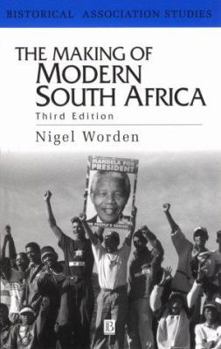The Making of Modern South Africa: Conquest, Apartheid, Democracy
Select Format
Select Condition 
Book Overview
The new edition of The Making of Modern South Africa provides a comprehensive, current introduction to the key themes and debates concerning the history of this controversial country. Engagingly... This description may be from another edition of this product.
Format:Paperback
Language:English
ISBN:0631216618
ISBN13:9780631216612
Release Date:August 2000
Publisher:Wiley-Blackwell
Length:208 Pages
Weight:0.65 lbs.
Dimensions:0.7" x 5.4" x 8.5"
Customer Reviews
1 rating
Great study on the History of Apartheid
Published by Thriftbooks.com User , 23 years ago
The structure and narrative of Nigel Worden's The Making of Modern South Africa: Conquest, Segregation and Apartheid is perhaps what makes this volume of the Historical Association Studies accessible not only to historians, but social historians who are looking beyond the nationalism of the African and Afrikaner to study how rural culture and townships in South Africa were affected from the colonial conquests of the 18th Century through the present. Maps of African societies in the nineteenth century; The Union of South Africa in 1910; "Native Reserves" of 1913 and 1936'; and the Bantustans, or Homelands, all provide a tangible, physical view of the changing nature of South Africa's political topography. Worden's extremely detailed Outline Chronology provides the reader with extensive information regarding South Africa from the "Pastoralist revolution" in c. 1000 BCE, through the British annexation of Natal in 1843, to the Introduction of Indian indentured laborers to Natal in 1860, which subsequently ended in 1911. Worden's Chronology illustrates how the making of apartheid was evident even before the South African "Boer" War in 1899-1902 with the Glen Grey Act of 1894 establishing separate land and tax systems for Africans on the eastern Cape.One of Worden's arguments states that the two explanations for the changing map of South Africa after the Zulu defeated the British were 1) Britain's desire to unify the region in order to control and 2) Britain was at this point in time representative of "the wider scramble for empire, particularly in Africa, amongst European powers." Worden's answer to these theories posited by historians prior to 1970 is that it was, in fact "The discovery of valuable mineral deposits and the need to secure labor supplies to mine them made the South African interior a highly desirable region for the British to control directly." (19) Yet mining was not the only available labor force in migrant labor. Many South Africans avoided wage labor by cultivating crops for commercial production, supplying the necessary cash for taxes and good. (46) The effect was a backlash with the victory of Het Volk in the 1907 Transvaal elections by "promis[ing] to restore white rural hegemony at the expense of African producers." (48) The Natives Land Act of 1913 passed by the Union Government forbade the purchase of land by Africans outside known reserves. Conflicts and resistance by South Africans was omnipresent and pronounced, and brought in the Industrial and Commercial Worker's Union (ICU), which ultimately weakened by the late 20s.After providing a heavy dose of the background against which Apartheid is placed, Worden proceeds to explain how racial discrimination in South Africa came to be. The process was part of European imperialism, into which ideas of the west being obligated to "civilize" natives hastened expansion, and the Darwinist idea of evolution was being applied to the human race. Unlike other nations where white s






